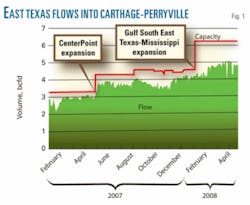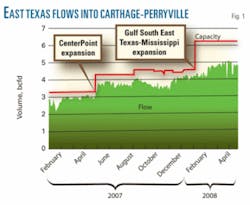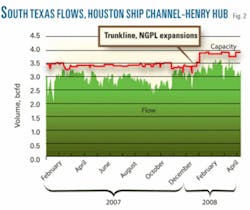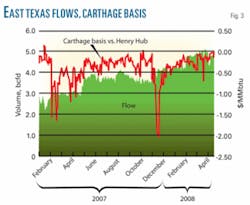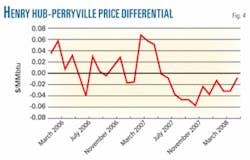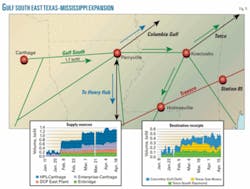The Texas-Gulf Coast natural gas pipeline buildout during the last year has caused price and flow changes offering a glimpse into what will likely take place as the construction boom continues. Even as these projects advance, however, the scope of announced storage projects in the region has raised the possibility of a large excess in capacity moving forward.
One of the most important pipeline projects affecting the Southeast-US Gulf region, CenterPoint’s Carthage-to-Perryville project, went online in May 2007, adding 1.2 bcfd of capacity between Carthage, Tex., and Delhi, La., near Perryville. Four other new projects entered service in first-quarter 2008. Three projects built by Trunkline, NGPL, and Gulf South increased capacity eastward out of Texas by 2.5 bcfd (OGJ, Apr. 28, 2008, p. 57). A fourth project on the Enbridge Texas pipeline system added upstream transportation from the Bossier Sands area of East Texas to South Texas.
This first part of two articles examines the basis shifts already underway and expected as a result of ongoing pipeline construction in the Texas-Gulf Coast region. The concluding article (next week) will detail planned Southeast US-Gulf Coast storage construction and examine the potential for overbuild.
Deliveries increase
Texas-Gulf Coast pipeline projects have led to a large increase in deliveries from Texas into the Southeast US-Gulf Coast region. Imports from Northeast Texas into the area via Carthage-Perryville are up an average of 1.8 bcfd so far in 2008 as compared to the same period in 2007, including a 1-bcfd gain on CenterPoint’s CP Line and a 700,000-MMcfd increase on Gulf South’s East Texas to Mississippi expansion. Figs. 1 and 2 show the flow and capacity patterns from East Texas to Perryville and South Texas into the Henry Hub via the Houston Ship Channel, respectively.
Despite limited capacity to move gas east from Perryville, the pipeline expansion projects have already led to price increases in the Carthage area and other parts of Texas.
Fig. 3 shows the Carthage Hub basis moving from an average of $0.54/MMbtu in the first 3 months of 2007 to $0.24/MMbtu for the same period in 2008. Carthage prices at the beginning of April were rapidly closing the gap with Henry Hub and may rise into positive territory compared to the Hub in reaction to new capacity between the Perryville Hub and delivery points at the edge of the Southeast US-Gulf Coast supply bubble.
Houston Ship Channel prices and basis have also gained substantial ground, moving from $0.49/MMbtu in first quarter 2007 to $0.30/MMbtu a year later and averaging $0.15/MMbtu for the first three weeks of April 2008. Carthage and the Houston Ship Channel have also closed the gap with points in the premium Southeast market, including Transco Zone 4. The Houston Ship Channel-Transco Z4 spread has dropped to $0.61/MMbtu on average in first-quarter 2008 compared to $0.84/MMbtu first-quarter 2007.
Flows shift
Since no new capacity east of Perryville has been placed into service yet, access to premium Southeast delivery locations, such as Transco Zone 4 and FGT Z3, remains constrained, causing incremental gas flow into Perryville to move primarily along Columbia Gulf.
The subsequent increase in deliveries to Columbia Gulf has led to a decrease in northbound flows out of Henry Hub to Perryville. Columbia Gulf reconfigured its Rayne compressor last year, allowing southbound flows to South Louisiana interconnects to accommodate the increased supply arriving into its system in the Perryville area. The company also reactivated two interconnections with Transco in South Louisiana and boosted capacity at its FGT interconnection in May, allowing more Perryville gas to reach premium market points in South Louisiana by displacement.
Northbound flows from Henry Hub to Perryville on Columbia have declined 700 MMcfd so far in 2008, compared with a year earlier. Although a net northbound flow on Columbia remains, the increased supply in the Perryville area is displacing enough northbound material from South Louisiana to effectively allow more gas to be delivered to South Louisiana interconnects.
Similar flow changes have occurred on Texas Gas and to a lesser degree Trunkline.
In contrast with previous years, when these pipes moved gas through Perryville and into the Midwest and Ohio Valley, they now deliver more gas into interconnects in South Louisiana, providing access to Southeast and Northeast markets. These flow shifts caused the price at Perryville to drop below Henry Hub last year when the Carthage-to-Perryville line went into service and continue to pressure Perryville pricing, which has averaged $0.02/MMbtu less than Henry Hub since January 2008 (Fig. 4), compared with a $0.04 premium to Henry Hub during first-quarter 2007.
Flows on the Gulf South ETX to MS Pipeline expansion have similarly increased supplies into Transco at Holmesville, Miss., and TETCO at Kosciusko, Miss.
Upcoming shift
The Gulf South Southeast Gulf expansion added 1.3 bcfd from Harrisville, Miss., into the Transco Zone 4 pool when it entered service May 31, 2008. The Southeast Supply Header will add 1.0 bcfd from Perryville, La., to Gulfstream in second-quarter 2008. These two developments will debottleneck the gas supply corridor between Perryville and the premium Southeast pricing region, shifting both west-east and north-south price differentials.
The remainder of this first part of the article will focus on Gulf South flows during the first 4 months of 2008 and examine a likely scenario of flow and pricing shifts as the Southeast Gulf expansion comes online.
Boardwalk’s Gulf South Pipeline is a network-based system that generally transports gas from northeastern and southeastern Texas into North Louisiana on two main pipeline legs. The pipeline also has traditionally transported supply from South Louisiana to the premium Southeast on another pipeline leg. Its latest East Texas-to-Mississippi expansion of 1.7 bcfd will allow Gulf South to flow additional gas from Carthage, Tex., across North Louisiana and into Mississippi.
Fig. 5 shows the general flow of gas on Gulf South when the East Texas to Mississippi expansion began service in January 2008. Flows move east from Carthage, Tex., to Perryville, La., and then to Harrisville, Miss., where deliveries occur into TETCO at Kosciusko, Miss., or to Transco at Holmesville, Miss.
Capacity east of Perryville on Gulf South, however, is subject to capacity constraints, moving a portion of the Carthage-to-Perryville flow into other pipelines at Perryville, primarily Columbia Gulf, and displacing gas that previously moved north from Henry Hub to Perryville.
Capacity increased to about 750,000 MMcfd in February and supplies from Energy Transfer’s HPL pipeline, Enterprise-Carthage, the DCP East Plant, and Enbridge filled the capacity almost immediately (Fig. 5). Capacity increased again Mar. 1 and Apr. 1 to 1.2 bcfd and 1.7 bcfd, respectively. Although the full 1.7 bcfd capacity is available, flows have yet to reach 1.4 bcfd, primarily because the Tallulah compressor station has not begun service, but is expected to now that the Southwest Expansion has begun operations.
Fig. 5 also shows the increase in volume moving into the expansion points via the Gulf South East Texas-to-Mississippi expansion. A large amount of the increased receipts, however, has been making its way to previously existing downstream delivery points on Gulf South’s mainline, particularly Transco Holmesville. Deliveries to Holmesville have increased to average 625 MMcfd as of late April, compared with a 2007 average of only 95 MMcfd. Flows into TETCO at Kosciusko, Miss., also gained more than 200 MMcfd. At the same time, about 450 MMcfd has been flowing into expansion delivery points, including Columbia Gulf at Delhi, La., Texas Gas at Bosco, La., and TETCO at South Raymond.
Opening the Gulf South Southeast Expansion allows Gulf South to flow 1.3 bcfd directly to Transco Station 85 vs. its previously limited access to the premium Southeast market (Fig. 6). Most of the new capacity will fill immediately, with the following consequences:
- Prices in the Transco Zone 4 pool will come under downward pressure, likely flattening the price differential between Carthage and Transco Station 85.
- Gulf South deliveries into Transco at Holmesville will decline.
- Supply pressures at Perryville will decline, resulting in lower deliveries into Columbia and other pipelines and a reduced incentive to displace gas moving from Henry Hub.
- Perryville prices will likely again move above Henry Hub for two reasons: higher prices at Perryville due to demand for supplies to move via the Southeast Expansion into Transco Zone 4, and downward pricing pressures at Henry Hub due to the displacement of traditional supplies moving into Transco Zone 4 from it and other South Louisiana locations.
The authors
Porter Bennett is president and CEO of Bentek Energy LLC in Golden, Colo. In his early career, Bennett held positions with consulting companies specializing in energy market analysis. He holds an MS in mineral economics from the Colorado School of Mines and an MA in international affairs from Columbia University in New York. He received a BA in history from Lewis & Clark College in Portland, Ore.
E. Russell Braziel is vice-president, marketing and sales, and chief technology officer for Bentek. He was previously vice-president of business development for the Williams Cos., vice-president of energy marketing and trading for Texaco, and president of Altra Energy Technologies. Braziel holds BBA and MBA degrees in business and finance from Stephen F. Austin University, Nacogdoches, Tex.
Jim Simpson is vice-president, operations, for Bentek. Before joining Bentek, Simpson modeled large structured transactions in both gas and power for Enron North America. Subsequently he led natural gas marketing and trading at MarkWest Hydrocarbon Inc. Simpson holds a BBA in finance from Texas A&M University.
